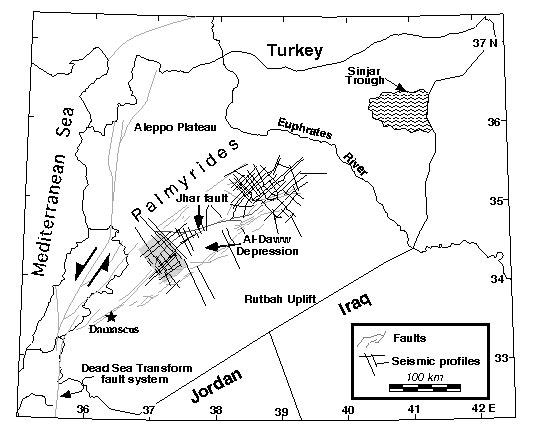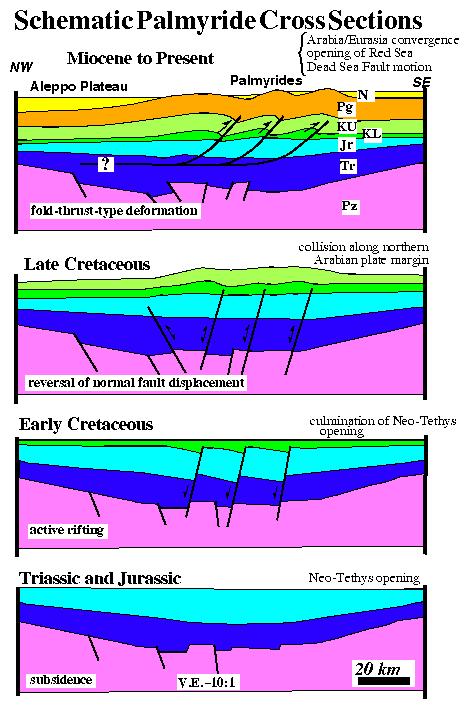Home | Results Summary | Publications | Participants | M.East / N.Africa Home
![]()
The Palmyride fold belt in central Syria is an intracontinental northeast-trending, 400 by 100 km transpressive belt embedded in the northern Arabian platform. During the Late Paleozoic and most of the Mesozoic the region of the present-day mountains was a rift-like trough that collected over 5 km of sediments, for a total Phanerozoic thickness of over 10 km. The southwestern sector of the fold belt is bounded in the north by the Jhar fault and in the south by the south-vergent frontal thrust faults of the Palmyrides, with the broad Al-Daww depression in between. Structural features that characterize the southern and southwestern region of the Palmyrides include a short wavelength, typically 5-10 km, fold style controlled by a regional low-angle décollement within Triassic beds, and small inverted Jurassic and Early Cretaceous normal faults.
Small intermontane basins (about 10 X 30 km) whose strata can be used to document the history of Palmyride deformation flank growth fault-bend folds and are mainly a product of Cenozoic shortening in the belt. These structures are elucidated by about 2000 km of newly available seismic reflection data in the Palmyrides. Synthetic seismic traces generated solely from forward modeling of outcrop information constrain seismic stratigraphic picks in two small basins about 100 km northeast of Damascus. There, minor Late Cretaceous uplift caused local onlap, marking the first inversion phase of the Palmyride trough. Tectonic quiescence throughout the Paleogene, interrupted only in the Middle Eocene by minor tectonism, resulted in monotonous deposition of about 2500 m of mostly limestone. Marked onlap and probable downlap of Lower Miocene strata onto an Oligocene angular unconformity indicate accelerated tectonism by Late Oligocene to Early Miocene time. This marks the beginning of the major phase of inversion and uplift of the Palmyrides. Recent seismicity indicates that transpression continues today.
Despite its relative remoteness from convergent plate boundaries (the nearest, the Bitlis suture in southern Turkey, is about 300 km distant), the Late Cretaceous, Middle Eocene, and Neogene phases of deformation in the intraplate setting of the Palmyrides have a direct temporal relationship with major regional tectonism that occurred along the surrounding Arabian plate boundaries. The Palmyride trough was inverted in Late Cretaceous time and, subsequently, developed into a transpressive zone throughout Neogene and Quaternary times. Thus, the initiation of inversion in the Palmyrides, an integral part of the Syrian Arc, which extends from central Syria southward to central Sinai, apparently predates development of the Red Sea/Dead Sea plate boundary. In contrast, the intense Neogene through Quaternary deformational episode is clearly related to development of the Red Sea/Dead Sea fault system and to convergence along the northern boundary of the Arabian plate in southern Turkey.
Figure 1. Palmyride seismic reflection data examined (a total of about 1000 km) and important features mentioned in text.

Figure 2. A scale comparison of the Transverse Ranges and central San Andreas fault system of California with the Palmyride Ranges and central Dead Sea fault system of the Middle East. A mirror image of the San Andreas system is shown in order to make the comparison more direct. Only major faults are shown. The Anti-Lebanon range in the Middle East is analogous to the Transverse Ranges of California, both being the result of compression in the region of the restraining bend of a major strike-slip fault. That is, the Palmyrides are not equivalent to the Californian Transverse Ranges, but are a result of the inversion of a preexisting basin.

Figure 3. Interpreted seismic reflection profile over Abou Rabah fault-bend fold. The heaviest line, slightly curved due to velocity pull up effects, represents the regional décollement in Triassic rocks. Synthetic seismic traces are used to constrain the detailed shallow stratigraphic picks (see Figure 4) in the basins to the NW and to the SE of Abou Rabah.

Figure 4. Example of a seismic reflection profile showing local baselap relationships used to determine the structural history of Palmyride uplift, shown with model velocities and the synthetic seismic traces that constrain shallow stratigraphic picks. Model velocities and thicknesses are based on outcrop.

Figure 5. Schematic NW-SE cross sections showing development, chronologically from bottom to top, of the southwestern intraplate Palmyride fold belt, with a list of related major Arabian plate boundary tectonic events.

Go back to Summary of Results
Go back to Cornell Syria Project Welcome Page